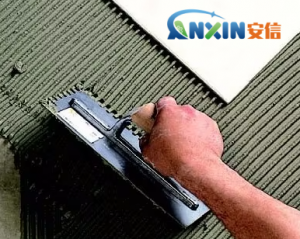Hydroxypropyl methylcellulose (HPMC) is a common water-soluble polymer cellulose ether. Due to its excellent thickening, water-retention, film-forming, lubricating, and workability-enhancing properties, it is widely used in dry-mix mortars for construction. In tile adhesive formulations, HPMC is an indispensable core additive, significantly improving the physical properties and workability of tile adhesives, thereby ensuring the secure and durable adhesion of tiles.
1. Water Retention
During the application process, tile adhesives work together with cement, quartz sand, and other additives. Water is a crucial condition for cement hydration and material hardening. However, in practical applications, substrates often have strong water absorption. Excessive water loss can lead to a decrease in bond strength or even failure.
HPMC dissolves in water to form a stable, viscous solution that forms a uniform water-retaining film within the adhesive, significantly reducing water loss during mixing. Its excellent water retention ensures:
Prolongs the cement hydration reaction time, promotes full cement reaction, and improves adhesive strength;
Prevents hollowing and flaking, enhancing the long-term stability of tiles;
Improves application adaptability, ensuring tile adhesion even at high temperatures or on highly absorbent substrates.
2. Thickening and Improving Rheological Properties
Tile adhesives require appropriate flow and thixotropic properties to facilitate application and maintain stability after tile installation, preventing runaway or sagging. The addition of HPMC can adjust the viscosity and rheological properties of the tile adhesive:
Increasing system viscosity ensures smooth application and adherence to the substrate during application;
Improving thixotropy allows the tile adhesive to exhibit improved flow when subjected to external forces (such as scraper application), facilitating spreading; and returning to a higher viscosity after standing, ensuring tiles remain stable and prevent slippage.
Optimizing application thickness: By adjusting the HPMC dosage and viscosity grade, the requirements for tile installations of varying thicknesses can be met.
3. Extending Open Time
Open time refers to the length of time tile adhesive remains effectively adhered after application. During actual installation, workers need time to position and adjust tiles. If the open time is too short, the tile surface loses its adhesive strength, resulting in a weak bond.
HPMC, with its water-retention and film-forming properties, can effectively extend the open time of tile adhesive, allowing for more flexible installation and reducing rework. HPMC is particularly effective in maintaining open time in high-temperature, low-humidity, or windy environments.
4. Enhancing Adhesion and Anti-slip Properties
One of the core properties of tile adhesive is bond strength. HPMC improves the bond between tile and substrate by:
Forming a uniform film: Forming a flexible polymer film at the interface between tile and substrate improves interfacial bonding;
Promoting uniform cement hydration: Improving the density of the cement paste, thereby enhancing overall bond strength;
Improving anti-slip properties: Especially when installing large or heavy tiles, HPMC effectively prevents tile slippage, ensuring smooth installation.
5. Improved Workability and Workability
Tile adhesive application requires smooth, labor-saving, and easy control. HPMC significantly improves the application performance of tile adhesive:
Improved lubricity: Easier application, reducing worker workload;
Improved slurry uniformity: Avoiding clumping and bleeding, resulting in a smoother tile adhesive coating;
Excellent compatibility: Optimized compatibility with various inorganic binders and polymer powders, maintaining formulation stability.
6. Adaptability to Various Environmental Conditions
Construction environments are complex, potentially subject to high and low temperatures, dryness, and humidity. HPMC’s improved environmental adaptability is primarily reflected in:
Maintaining water retention in high-temperature environments, preventing rapid dehydration of the tile adhesive;
Providing moderate workability in low-temperature conditions, ensuring slow and complete hydration of the cement;
Significantly reducing the impact of water absorption on highly absorbent substrates (such as aerated concrete).
7. Economic Efficiency and Overall Value
Although HPMC is used in small quantities as a polymer additive (typically only 0.1% to 0.5% of the powder weight in tile adhesive), it offers significant comprehensive benefits:
Reduced rework costs: Reduced tile peeling and hollowing rates;
Improved construction efficiency: Extended working time and smoother installation;
Enhanced durability: Improved overall bond strength and crack resistance, ensuring longer-lasting tile installations.
HPMC plays a core role in tile adhesives: retaining water and thickening, extending open time, strengthening adhesion, improving anti-slip properties, enhancing workability, and adapting to complex construction conditions. By improving the physical and chemical properties of tile adhesives, it provides reliable support for construction projects. It can be said that without HPMC, the performance of modern tile adhesives would be significantly compromised.
Post time: Sep-01-2025

